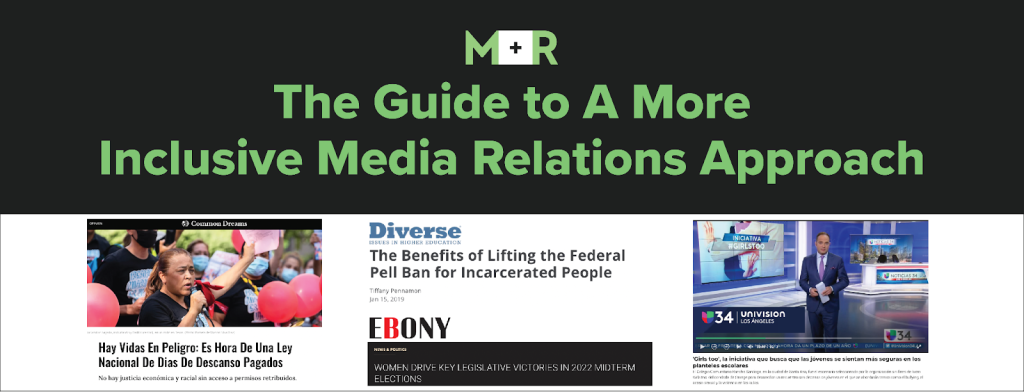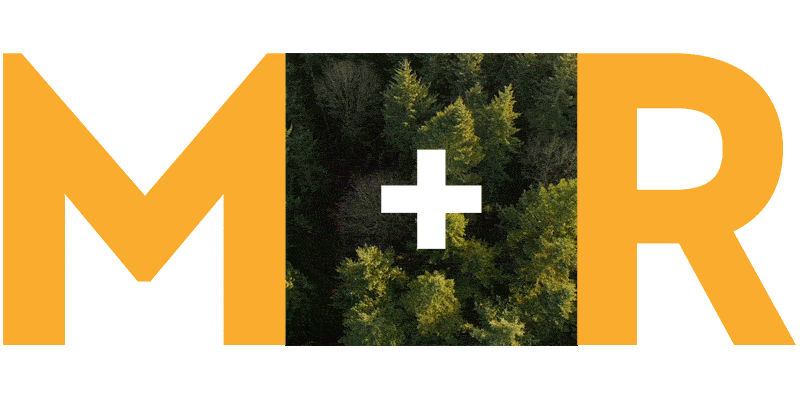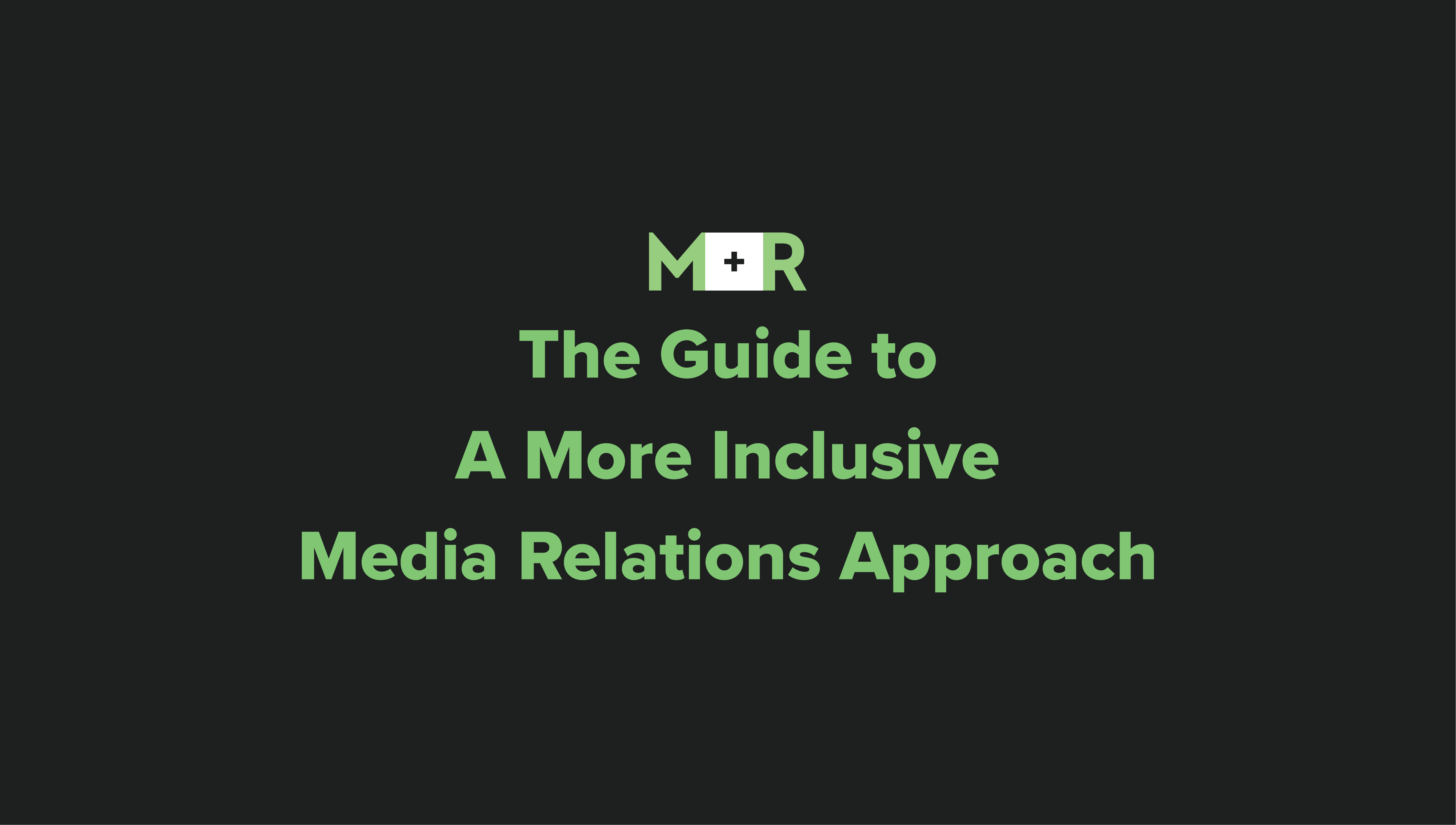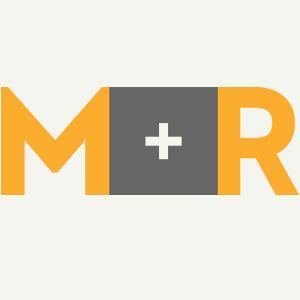We work across a range of issue spaces at M+R, including immigration, reproductive rights, LGBTQ+ rights, criminal legal system reform, affordable housing, and countless others. We spend a lot of our time working on policy specifics and the political factors needed for change, but at the end of the day our work is really about the people at the heart of these policies. Whether we’re working to shed light on longstanding inequalities, change discriminatory practices, or ensure opportunities for folks from historically marginalized communities, much of our work shares one common overarching goal: striving towards equity.
While we push ourselves and our clients every day toward a more equitable future, we’re also continually evaluating our internal structures to determine how we can bring an equity-centered approach to all of our work. The idea for an inclusive media guide was created out of that focus, and our Newsies team — a subset of staff from our Media Relations department — worked to bring it to fruition.
To back up: Many communications professionals have long viewed the traditional mainstream outlets (such as The Washington Post, New York Times, and the main broadcast news networks) as the gold standard, regardless of who their work impacts or who their audiences are. But these outlets, while popular, typically cater to a white, middle- to upper-class audience, and that might not always be who you need to reach. Depending on your goals, it may be more efficient to focus on getting coverage in smaller, more niche outlets rather than spending all your energy on pitching mainstream reporters who quite literally get hundreds of pitches a day.
As folks working in media relations, we try to never assume our target audience consumes the same news sources that we do. Working with reporters from smaller, independent, and/or BIPOC- or queer-led outlets is also a wonderful way to support journalists of color, who are often underrepresented in the newsrooms of major media companies.
We encourage all media relations professionals (and we include ourselves here!) to consider the following questions:
- Who needs to hear more about the advocacy work for a given issue?
- Whose stories need to be told?
- Where could those stories make the most difference?
If we all asked these questions at the outset of every new project, our media strategies would probably look quite different. But we’re all pressed for time and constrained by the old way of doing things. That’s where this guide comes in.

This guide is meant to be a helpful map for when you’re starting to think about new projects and communications plans, but it can also be used as a resource for existing projects to make sure you’re not leaving out any often-overlooked outlets and reporters.
Index:
- Planning and pitching considerations
- BIPOC News Outlets
- Guiding questions for identifying storytellers
- Language to use + avoid in pitches
- Additional resources
Planning and pitching considerations
Below are some questions to think through as you’re building your media list, identifying what a “media win” is for your organization, and/or thinking about where to pitch your next op-ed.
Audiences & Outlets
- What are the overarching goals for this project?
- What would an ideal article or broadcast segment about this project look like?
- What is our ideal headline?
- What types of media outlets do we want to target?
- Can or should you consider non-English speaking outlets?
- If your team decides this answer is “yes,” here are, some additional questions to consider:
- How will your team address translation needs? Will you need to budget for translation services, or does your organization have in-house translation services?
- If opting for in-house translation, how can you make sure that the relevant team members are included in your project from the beginning and have the necessary context on the project?
- If your team decides this answer is “yes,” here are, some additional questions to consider:
- Who is the audience you’re trying to reach?
- Is the primary or secondary audience a community of color or otherwise marginalized group of people (such as the queer, disability, and immigrant communities)? If so, which outlets are most impactful in that community? Which format will reach the largest subset of people: Is it print, digital, radio, broadcast, or something else?
Angles
- Who is directly impacted or harmed by the issues you work on?
- How does this news affect communities of color or non-English speaking communities?
- Is there a product you’re promoting, such as a report release or new data? How do the findings affect BIPOC or other marginalized communities?
BIPOC News Outlets
As a starting point, we recommend reaching out to BIPOC media outlets with national reach. A few examples include:
We also recommend exploring BIPOC sections and verticals in mainstream outlets, such as NBCBLK, Bloomberg Equality, NPR Code Switch and the L.A. Times’ new equity reporting initiative.
Guiding questions for identifying storytellers
Storytellers are often the most critical piece of any media campaign. Hearing from someone who has been directly impacted by immigration law, the criminal legal system, or housing policy can help change hearts and minds more than a list of talking points ever will. As you think through what kind of stories you want to tell and which voices are most appropriate to share those stories, here are some questions to think through:
- Which perspectives are missing in the existing story/narrative, and which voices could most effectively add to it?
- Who are the people on the ground already doing the work on this issue, and how can we uplift their stories and expertise?
- How can we leverage media interest to highlight underrepresented voices and perspectives in a way that isn’t exploitative?
- How can we build a supportive and trusting relationship with our storyteller(s), rather than one that’s transactional?
- Which resources do we need to share the stories of non-English speakers?
- Which resources do we need to communicate our stories to non-English speaking outlets?
- What kind of work can we, as media relations professionals, do on the front end to ensure the safety and security of those sharing their stories?
- Are we prepared to support storytellers before, during, and after they share their stories, especially if traumatic experiences are involved? What does that support look like?
- What does staffing look like when a storyteller is sharing their perspective? Are our staff trained to appropriately step in and shift the conversation if the reporter’s questions become invasive or inappropriate?
- Which mechanisms for feedback do we have in place for storytellers to share how this experience went for them? How do we continuously evaluate and improve our work with storytellers?
Language to use + avoid in pitches
We always want to be mindful of the language we use to describe impacted people and communities. Below are some examples of alternative language to use when discussing disabilities, incarceration, immigration, and substance use — four identities that are frequently misrepresented in the media. To learn more about inclusive language, including how it intersects with race, gender, sexuality, and other identities, we recommend reading through this Inclusive Language Guide from Feminuity.
Disabilities
- People-first language refers to the person first + disability second
- “Person with a disability” instead of “the disabled or handicapped”
- “Person who uses a wheelchair” instead of “Wheelchair bound or confined to a wheelchair”
- A note about people-first language: While people-first language has become more widely used over the last several years, not everyone prefers using these terms to describe themselves. The best course of action is to always politely ask what language the individual uses to describe themselves, and if they would like you to use the same.
Incarceration
- Terms to avoid: Inmates, convicts
- Alternatives: “Incarcerated people,” “Imprisoned people,” “people in prison,” “people in jail,” “people jailed in X facility,” “formerly incarcerated people,” “Jane Doe, who is serving 12 years in San Quentin State Prison” (more examples here)
- Terms to avoid: Felon, offender, sex offender, offense, parolee, probationer
- Alternatives: “Jane Doe was convicted of felony robbery,” “Joe Doe was on trial for criminal loitering, a low-level offense,” “Jane Doe was placed on probation in June”
Immigration
- Terms to avoid: Alien, illegal alien, illegal immigrant
- Alternatives: Undocumented, noncitizen
Substance use
- Terms to avoid: Addict, abuser, junkie
- Alternatives: “Someone struggling with addiction” or “person with a substance use disorder”
Examples
Our favorite media wins are the ones that highlight often-ignored perspectives, push for systemic change, and inspire others to take action. We’re particularly proud of our team’s work in shaping the following pieces:
Word in Black: New Report Reveals Air Pollution Is No Joke for Black People
April 21, 2023
Sunday Civics: Episode 215: Trafficking in the Fear of Crime
Aired April 9, 2023
The Jewish News of Northern California: Opinion: Home is sacred. California must pass stronger tenant protections.
By Rabbi Jocee Hudson
April 19, 2023
Common Dreams: Hay Vidas En Peligro: Es Hora De Una Ley Nacional De Dias De Descanso Pagados
By Vicky Badillo
September 22, 2022
Capital B: How Will Climate Change Affect the Search for a New Black Mecca in the South?
June 30, 2022
The 19th: Pregnant people and their babies are at risk from wildfire smoke and air pollution
April 21, 2022
Moving forward
Our industry is strongest when we evaluate our long-held practices, openly share our reflections and recommendations, and learn from each other. Our hope is that this guide encourages you to start a conversation with your colleagues about your own organization’s approach to inclusive media relations. What are some of your strengths in this regard? Where do you see room for growth? Has your organization developed any best practices when it comes to working with storytellers, or using inclusive language?
We’d love to hear what you’re doing to implement a more inclusive approach to media relations – feel free to drop us a line at Newsies@mrss.com. We look forward to hearing from you!
Additional resources
Quoting Immigrants: A Media Toolkit for Anonymous Sources from Define American
- Recommendations on Anonymity
- How to Talk to Sources About Using Their Name
- Know the Risks
- Tips for Visual Media
- Reporting on Minors
Language, Please style guide
A free, living resource for journalists and storytellers seeking to thoughtfully cover evolving social, cultural, and identity-related topics.
Trans Journalists Association’s Style Guide
A tool reporters, editors and other media makers can use to begin to improve coverage of the trans community. It gives insight into appropriate language, common shortcomings, and steps journalists can take to make their coverage better.



